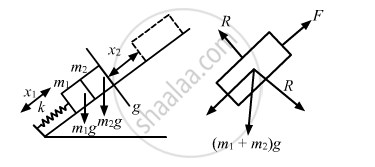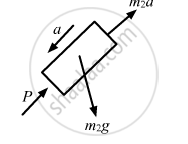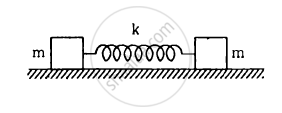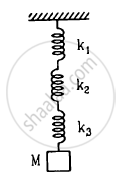Advertisements
Advertisements
प्रश्न
The block of mass m1 shown in figure is fastened to the spring and the block of mass m2 is placed against it. (a) Find the compression of the spring in the equilibrium position. (b) The blocks are pushed a further distance (2/k) (m1 + m2)g sin θ against the spring and released. Find the position where the two blocks separate. (c) What is the common speed of blocks at the time of separation?

उत्तर
(a) As it can be seen from the figure,
Restoring force = kx
Component of total weight of the two bodies acting vertically downwards = (m1 + m2) g sin θ
At equilibrium,
kx = (m1 + m2) g sin θ
\[\Rightarrow x = \frac{\left( m_1 + m_2 \right) g \sin \theta}{k}\]

(b) It is given that:
Distance at which the spring is pushed,
\[x_1 = \frac{2}{k}\left( m_1 + m_2 \right)g \sin \theta\]
As the system is released, it executes S.H.M.
where \[\omega = \sqrt{\frac{k}{m_1 + m_2}}\]
When the blocks lose contact, P becomes zero. (P is the force exerted by mass m1 on mass m2)
\[\therefore m_2 g \sin \theta = m_2 x_2 \omega^2 = m_2 x_2 \times \frac{k}{m_1 + m_2}\] \[ \Rightarrow x_2 = \frac{\left( m_1 + m_2 \right) g \sin \theta}{k}\]
Therefore, the blocks lose contact with each other when the spring attains its natural length.
(c) Let v be the common speed attained by both the blocks.
\[\text { Total compression } = x_1 + x_2 \]
\[\frac{1}{2} \left( m_1 + m_2 \right) v^2 - 0 = \frac{1}{2}k \left( x_1 + x_2 \right)^2 - \left( m_1 + m_2 \right) g \sin \theta \left( x + x_1 \right) \]
\[ \Rightarrow \frac{1}{2}\left( m_1 + m_2 \right) v^2 = \frac{1}{2}k\left( \frac{3}{k} \right) \left( m_1 + m_2 \right) g \sin \theta - \left( m_1 + m_2 \right) g \sin \theta \left( x_1 + x_2 \right)\]
\[ \Rightarrow \frac{1}{2}\left( m_1 + m_2 \right) v^2 = \frac{1}{2} \left( m_1 + m_2 \right) g \sin \theta \times \left( \frac{3}{k} \right) \left( m_1 + m_2 \right) g sin \theta\]
\[ \Rightarrow v = \sqrt{\left\{ \frac{3}{k} \left( m_1 + m_2 \right) \right\}}g \sin \theta\]
APPEARS IN
संबंधित प्रश्न
A particle is in linear simple harmonic motion between two points, A and B, 10 cm apart. Take the direction from A to B as the positive direction and give the signs of velocity, acceleration and force on the particle when it is
(a) at the end A,
(b) at the end B,
(c) at the mid-point of AB going towards A,
(d) at 2 cm away from B going towards A,
(e) at 3 cm away from A going towards B, and
(f) at 4 cm away from B going towards A.
A particle executes simple harmonic motion with an amplitude of 10 cm. At what distance from the mean position are the kinetic and potential energies equal?
A particle having mass 10 g oscillates according to the equation x = (2.0 cm) sin [(100 s−1)t + π/6]. Find (a) the amplitude, the time period and the spring constant. (c) the position, the velocity and the acceleration at t = 0.
The equation of motion of a particle started at t = 0 is given by x = 5 sin (20t + π/3), where x is in centimetre and t in second. When does the particle
(a) first come to rest
(b) first have zero acceleration
(c) first have maximum speed?
A block suspended from a vertical spring is in equilibrium. Show that the extension of the spring equals the length of an equivalent simple pendulum, i.e., a pendulum having frequency same as that of the block.
In following figure k = 100 N/m M = 1 kg and F = 10 N.
- Find the compression of the spring in the equilibrium position.
- A sharp blow by some external agent imparts a speed of 2 m/s to the block towards left. Find the sum of the potential energy of the spring and the kinetic energy of the block at this instant.
- Find the time period of the resulting simple harmonic motion.
- Find the amplitude.
- Write the potential energy of the spring when the block is at the left extreme.
- Write the potential energy of the spring when the block is at the right extreme.
The answer of b, e and f are different. Explain why this does not violate the principle of conservation of energy.

Consider the situation shown in figure . Show that if the blocks are displaced slightly in opposite direction and released, they will execute simple harmonic motion. Calculate the time period.

Find the elastic potential energy stored in each spring shown in figure when the block is in equilibrium. Also find the time period of vertical oscillation of the block.

Discuss in detail the energy in simple harmonic motion.
Show that for a particle executing simple harmonic motion.
- the average value of kinetic energy is equal to the average value of potential energy.
- average potential energy = average kinetic energy = `1/2` (total energy)
Hint: average kinetic energy = <kinetic energy> = `1/"T" int_0^"T" ("Kinetic energy") "dt"` and
average potential energy = <potential energy> = `1/"T" int_0^"T" ("Potential energy") "dt"`
When a particle executing S.H.M oscillates with a frequency v, then the kinetic energy of the particle?
A body is executing simple harmonic motion with frequency ‘n’, the frequency of its potential energy is ______.
Motion of an oscillating liquid column in a U-tube is ______.
A body is performing S.H.M. Then its ______.
- average total energy per cycle is equal to its maximum kinetic energy.
- average kinetic energy per cycle is equal to half of its maximum kinetic energy.
- mean velocity over a complete cycle is equal to `2/π` times of its π maximum velocity.
- root mean square velocity is times of its maximum velocity `1/sqrt(2)`.
Draw a graph to show the variation of P.E., K.E. and total energy of a simple harmonic oscillator with displacement.
A body of mass m is attached to one end of a massless spring which is suspended vertically from a fixed point. The mass is held in hand so that the spring is neither stretched nor compressed. Suddenly the support of the hand is removed. The lowest position attained by the mass during oscillation is 4 cm below the point, where it was held in hand.
What is the amplitude of oscillation?
The total energy of a particle, executing simple harmonic motion is ______.
where x is the displacement from the mean position, hence total energy is independent of x.
